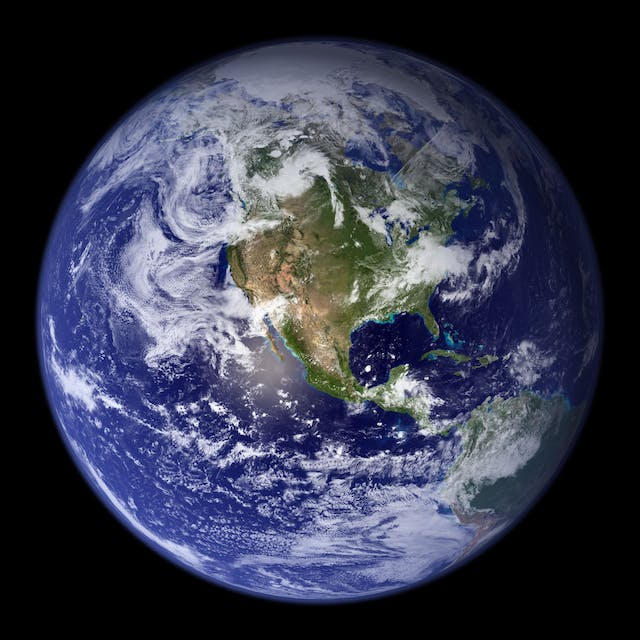
How thick is the atmosphere? The atmosphere is generally considered to be 10,000 km thick.
Our atmosphere is made up of gas. It is 78% nitrogen, 21% oxygen, and one percent other gases. Those other gases are argon, carbon dioxide, helium, neon, methane, krypton, and hydrogen. There is water vapor as well, which is a mix of the other gases. Water vapor is 0.4% of the atmosphere on average, but it can range from 4% in very humid places to 0% over the poles.
We have an atmosphere because of the gravity on Earth and because of the magnetic field around our planet. Everything on Earth is pulled towards the core of the planet by gravity. In order to escape this gravity and leave the planet, an object needs to reach 11 km per second, the escape velocity. Lighter particles, such as hydrogen and helium, can reach these speeds and shoot out into space, which is why there are not many light elements in the atmosphere, but heavier elements are slower and gravity keeps them in. The magnetic field is also vital. Every star gives off a stream of particles called the solar wind. If a planet doesn’t have the protection of a magnetic field, these particles can collide with the atmosphere and slowly strip it from a planet. Mars doesn’t have an atmosphere because its smaller size gives it a lower gravity and it doesn’t have a magnetic field. Mars probably lost its atmosphere 4.1 billion years ago.
The atmosphere is vital to life on Earth. It does so many things that we are probably not aware of. First of all, obviously, it gives us air to breathe. Without the gases in the atmosphere, no animal life would be able to survive here. The atmosphere protects us from UV radiation. It creates the pressure that means water can become a liquid on the surface. With no atmosphere, the water would evaporate and be lost to space. The atmosphere also keeps our planet at a suitable temperature. Planets with no atmosphere suffer from extremes of heat depending on if they are facing their sun or not.
The atmosphere is divided up into five layers. The troposphere is the lowest layer and it stretches from the surface of Earth to between 10 km up at the poles and 18 km up at the equator. The difference is because the equators are hotter and the heat rising off the land drives the air higher than at the poles. 75% of all air is on the troposphere because gravity pulls it down towards the surface of the Earth. The second layer is the stratosphere. It goes from the edge of the troposphere to about 50 km up. Most of the ozone is in this layer and it absorbs and blocks UV radiation. The third layer is the mesosphere and it goes from the stratosphere to a height of 85 km. The fourth layer is the thermosphere and it goes from the mesosphere to about 600 km. The International Space Station orbits in this layer. The last layer is the exosphere and it goes from the thermosphere to a distance of about 10,000 km.
So, how thick is the atmosphere? This is a difficult question because there is no single point where the Earth’s atmosphere ends and space begins. It is not you are travelling through the atmosphere and then suddenly there is no more atmosphere. It gets thinner and thinner until there is nothing left. NASA and the US military say that space starts at 80 km up. Internationally, the Karman line at 100 km is the accepted start of space. The difference is probably because international law says that outer space is free to explore, and the US want more outer space in which to explore. The Karman line was set as the start of space because 99.99997% of Earth’s atmosphere is below the line. However, there is still atmosphere above this line if, by atmosphere, we are talking about the molecules that make up the gases in the atmosphere. These molecules are very spread out, but they are still denser than outer space. There are also enough of them to produce drag on anything that orbits the Earth in this layer. These particles could be considered as separate to the atmosphere, but they are still gravitationally bound to Earth and they are orbiting.
It could be argued that the atmosphere extends to 200,000 km because this is the distance at which the solar wind exerts more pull on the molecules than the Earth’s gravity does. However, by this point, there are so few particles that there is very little difference between this area and outer space. Most scientists agree with the distance of 10,000 km. And this is what I learned today.
Photo by Pixabay: https://www.pexels.com/photo/planet-earth-87651/
Sources
https://www.space.com/17683-earth-atmosphere.html
https://climate.nasa.gov/news/2914/the-atmosphere-earths-security-blanket/
https://scied.ucar.edu/image/gases-earths-atmosphere
http://www.atmo.arizona.edu/students/courselinks/fall16/atmo336/lectures/sec1/composition.html
https://niwa.co.nz/education-and-training/schools/students/layers

